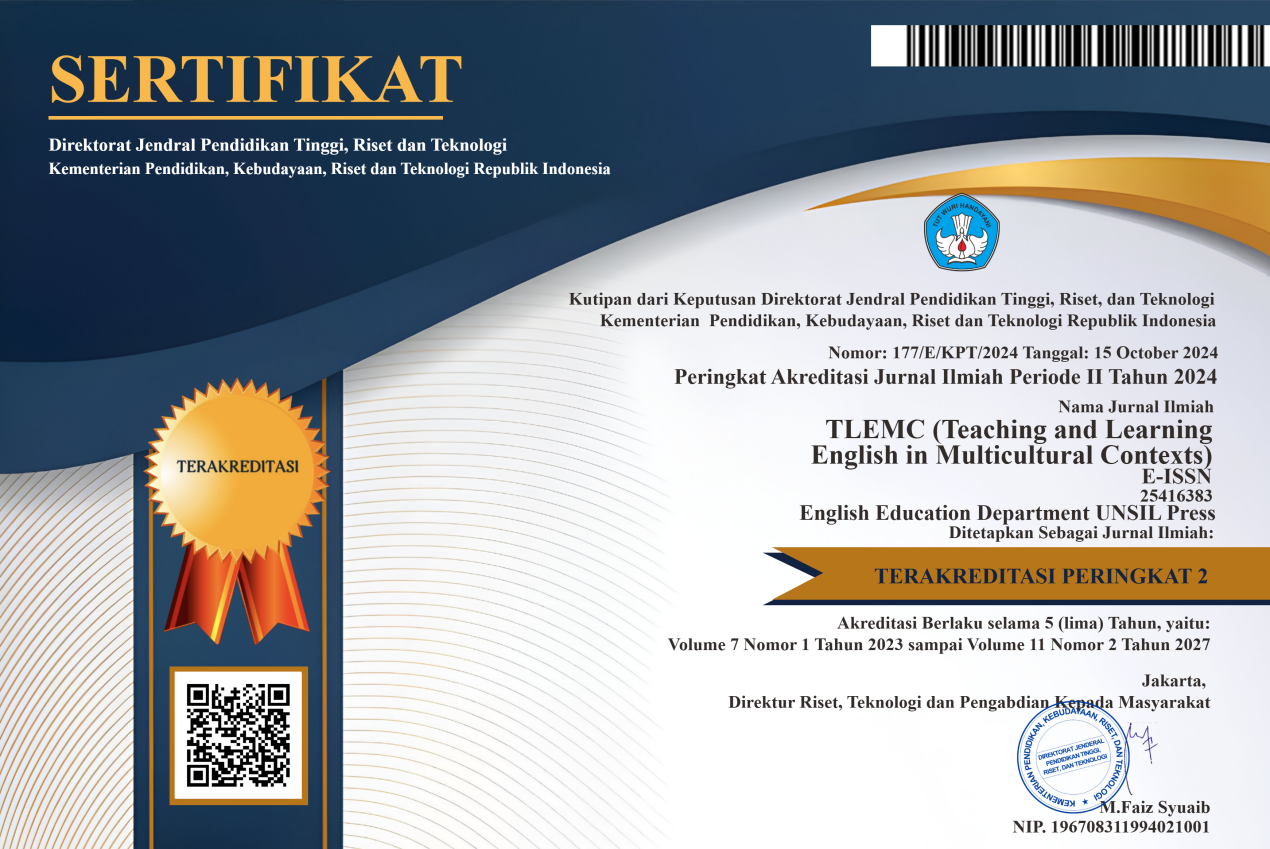Speech Acts Analysis of Spiderman No Way Home Movie as A Medium of Learning Material
Abstract
A movie is one of the beneficial teaching media. Its main function is for entertainment, but it is a good resource for language learning as well. The dialog in the movie provides material for learning language skills and language structure which can be learned for any element of language. In this research, the writer investigated the language structure focused on speech acts. The study aims to identify the types of speech acts delivered by the main actor in the Spider-man movie, which was used a learning material, along with their frequency. This research was conducted in descriptive qualitative method. The analysis of speech acts used Searle’s theory which divided speech acts into five classifications, commissive, declarative, directive, expressive, and representative. After analyzing, the writer found all types of speech acts in the conversations. Although, the amount utterances of each type are various. Directive (46%) is frequently used in the dialogue followed by expressive (30%) commissive (12%), declarative (6%), and representative (6%). Therefore, expressions such as command, order, request, thank, apology, etc., which are parts of the directive and expressive type, often appear in conversation, especially in action movies.
Â
Keywords: Speech act, learning material, movie
Full Text:
PDFReferences
Albiladi, W. S., Abdeen, F., & Lincoln, F. (2018). Learning English through movies: Adult English language learners’ perceptions. Theory and Practice in Language Studies, 8(12), 1567–1574. https://doi.org/10.17507/tpls.0812.01
Altikriti, S. F. (2011). Speech act analysis to short stories. Journal of Language Teaching and Research, 2(6), 1374-1384.
Aminatun, D. (2019). ICT in university: How lecturers embrace technology for teaching. Jurnal Smart, 5(2), 71-80.
Austin, J. L. (1989). How to do things with words. Edited by J. O. Urmson and Marina Sbisa. Oxford: Oxford University Press.
Bayat, N. (2013). A study on the use of speech acts. Procedia-social and behavioral sciences, 70, 213-221.
Cutting, J. (2002). Pragmatics and Discourse. London: Routledge
Dzulfahmi, N., & Nikmah, A. (2020). The effects of using movies in improving vocabulary and motivation to learn among students across different age groups. Britania Journal of English Teaching, 3(1).
Ebrahimi, Bazaee. (2016). The effect of watching English movies with standard subtitles on efl learners’ content and vocabulary comprehension. Journal of Applied Linguistics and Language Research, 3(5), 284-295.
Fotion, N. (2000). John Searle. Princeton: Princeton University Press.
Gowasa, N. S., Radiana, S. P., & Afifah, N. (2019). A study on the use of speech acts: A review of selected paper. ELSYA: Journal of English Language Studies, 1(2), 55-60.
Harmer, J. 2007. The Practice of English Language Teaching 4th ed. London: Longman.
Kalra, R. (2017). The effectiveness of using films in the EFL classroom: A case study conducted at an International University in Thailand. Arab World English Journal (AWEJ), 8(3).
Kroeger, P. R. (2023). Analyzing meaning: An introduction to semantics and pragmatics. Language Science Press.
Kusumawardhani, P., & Nurhayati, N. (2019). The Analysis of Teaching Writing to English Young Learners (EYL) through a Movie: An ICT Perspective. Wanastra: Jurnal Bahasa dan Sastra, 11(1), 25-36.
Mabaquiao, N. (2013). Of words and their meanings: Introducing the philosophy of language. Exploring the philosophical terrain. ed. Elenita Garcia. Quezon City: C & E Publishing, Inc, 76-93.
Mabaquiao, N. (2018). Speech Act Theory: From Austin to Searle. A Journal for Humanities, Social Sciences, Business, and Education, 2018, 19 (1): 35-45.
Nordquist, R. (2017). Pragmatics gives Context to Language.
Thoughtcom. Available on: https://www. thoughtco. com/pragmatics-language-1691654 Search in.
Oxford, R. (2001). Integrated skills in the ESL/EFL Classroom. ERIC Digest 2002-2. Retrieved from http://www.ericdigests.org/2002-2/esl.htm
Rahmawati, R. D. (2021). An analysis of expressive speech acts used in Crazy Rich Asian movie. Journal of Language and Literature, 9(1), 83-94.
Rahayu, F. N., Arifin, M. B., & Ariani, S. (2018). Illocutionary act in the main characters’ utterances in mirror mirror movie. Jurnal Ilmu Budaya, 2(2), 175–187.
https://doi.org/http://dx.doi.org/10.30872/jbssb.v2i2.1065
Rokni, S. J. A., & Ataee, A. J. (2014). Movies in EFL classrooms: With or without subtitles. The Dawn Journal, 3(1), 715-726.
Roslim, N., Azizul, A. F., Nimehchisalem, V., & Abdullah, M. H. T. (
. Exploring movies for language teaching and learning at the tertiary level. Asian Journal of University Education (AJUE), 17(3), 271-280.
Sabouri, H., Zohrabi, M., & Osbouei, Z. K. (2015). The impact of watching English subtitled movies in vocabulary learning in different genders of Iranian EFL learners. International Journal on Studies in English Language and Literature, 3(2), 110-125.
Searle, John. (1979). Expression and meaning: Studies in the theory of speech acts. Cambridge: Cambridge University Press.
Shi, Y. (2016). Research on integrated education mode in college English teaching. In SHS Web of Conferences (Vol. 25, p. 01012). EDP Sciences.
Silvani, D. (2020). Learning through Watching: Using Animation Movie to Improve Students’ Writing Ability. Journal of English Language Teaching and Linguistics, 5(2), 233-247.
Yazici, Y. (2020). Movieoke in language learning classes. European Journal of Education Studies, 7(10).
Yule, G. (2006). Pragmatics. New York: Oxford University Press
DOI: https://doi.org/10.37058/tlemc.v7i1.7662
Refbacks
- There are currently no refbacks.
INDEXED BY:
This work is licensed under a Creative Commons Attribution-NonCommercial-ShareAlike 4.0 International License.
![]()
TLEMC (Teaching and Learning English in Multicultural Contexts)
Program Studi Pendidikan Bahasa Inggris
Fakultas Keguruan dan Ilmu Pendidikan
Universitas Siliwangi
Jl. Siliwangi No. 24 Kota Tasikmalaya - 46115
email: tlemc@unsil.ac.id





